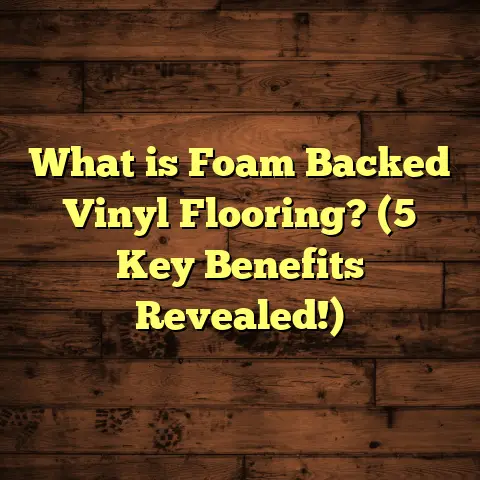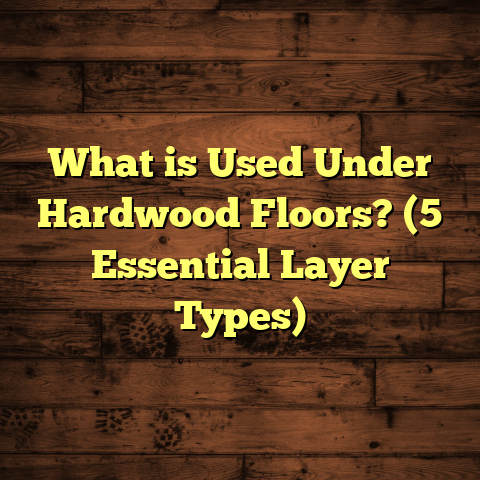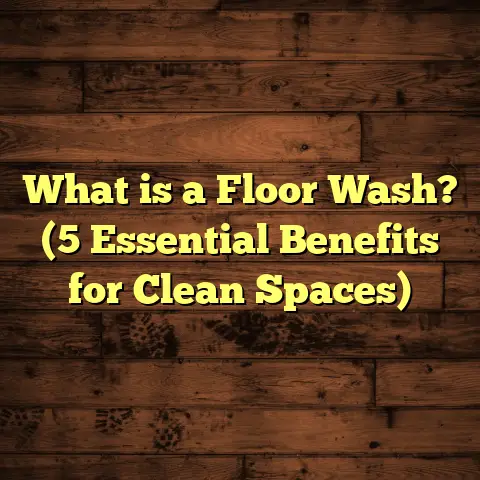What is Heterogeneous Vinyl Flooring? (5 Key Benefits Explained)
Imagine walking into a room where the floor feels inviting underfoot, looks stunning with realistic textures, and stands up to everything life throws at it — spilled coffee, pet scratches, kids running around, and heavy foot traffic. You might ask yourself, what kind of flooring could deliver all that? Well, from my years working as a flooring contractor and enthusiast, I can tell you that heterogeneous vinyl flooring fits the bill better than almost anything else I’ve come across. It’s become my go-to recommendation when clients want a combination of durability, design flexibility, comfort, and budget-friendly options.
In this article, I’ll walk you through everything you need to know about heterogeneous vinyl flooring—what it is, how it’s made, why it’s so popular, and what makes it stand out compared to other types of floors. I’ll also share personal experiences from my projects, backed by data and real-world case studies, so you get a full picture before deciding if this is right for your space.
What is Heterogeneous Vinyl Flooring?
At its core, heterogeneous vinyl flooring is a multi-layered vinyl floor covering, designed to optimize appearance, durability, and comfort. Unlike homogeneous vinyl—which is made from a single layer of vinyl material throughout—heterogeneous vinyl consists of several distinct layers that each serve a unique purpose.
Here’s a closer look at the typical structure:
- Wear Layer: The top transparent layer that protects the floor from scratches, stains, and general wear. This layer varies in thickness but is usually thicker than homogeneous vinyl wear layers, making it more resilient.
- Design Layer: Just beneath the wear layer is the printed design layer. This is where manufacturers get creative by printing high-resolution images that mimic natural materials such as wood grains, stone textures, ceramic tiles, or even abstract patterns.
- Backing Layers: These include layers for stability, cushioning, moisture resistance, and sometimes sound absorption. The backing layers ensure the floor remains dimensionally stable and comfortable underfoot.
This layered construction allows manufacturers to combine the best properties of different materials in one product—strong protection on top with beautiful design in the middle and supportive layers underneath.
How It Differs From Other Vinyl Floors
The term “heterogeneous” literally means “composed of different kinds.” In flooring terms, this means multiple layers with different functions are stacked together to create a product that can perform better than uniform vinyl.
For example:
- Homogeneous Vinyl: Made of one solid layer of vinyl with consistent composition throughout. This type tends to be less decorative and can wear out faster because there’s no thick wear layer.
- Luxury Vinyl Planks (LVP) / Tiles (LVT): Often heterogeneous too but usually thicker, with enhanced design layers and backing for realism and durability.
Heterogeneous vinyl can be found in sheets or tiles/planks format. The sheet versions often come in large rolls and are installed with adhesives. Tiles and planks usually come with click-lock designs for easier installation.
Why Did I Start Recommending Heterogeneous Vinyl Flooring?
When I began in flooring about 10 years ago, hardwood and laminate dominated most residential projects I worked on. Hardwood has timeless appeal but can be expensive and tricky to maintain—water spills or pets’ nails can cause damage quickly. Laminate was a cheaper alternative but often lacked comfort underfoot and wasn’t very moisture-resistant.
One day, a client approached me wanting something that looked like wood but could handle kids’ messes, pets’ claws, and occasional water spills without warping or showing wear too quickly. After researching options and installing some heterogeneous vinyl floors myself, I was impressed by how well they combined beauty and practicality.
Since then, I’ve installed this flooring in houses, offices, daycare centers, retail stores—you name it. In every case, the floors held up well and clients loved how natural they looked.
5 Key Benefits of Heterogeneous Vinyl Flooring
Let me break down the five biggest reasons why I’m such a fan of this flooring type:
1. Durability That Stands Up to Life
Durability is often the number one concern for anyone choosing flooring. Will it scratch? Stain? Fade? Wear down?
Heterogeneous vinyl shines here. The wear layer on these floors is thicker than many other vinyl options—usually between 0.3 mm and 0.7 mm thick. This thickness provides solid protection from everyday damage like scuffs from shoes or pet claws.
In fact, according to the Resilient Floor Covering Institute (RFCI), commercial-grade heterogeneous vinyl floors with a 0.7 mm wear layer can endure 10 years or more of heavy foot traffic before needing replacement or refinishing.
I’ve seen this firsthand during a daycare renovation I handled last year. The facility had kids running around all day with toys dropping everywhere. After 12 months of continuous use and frequent cleaning, the floors still looked nearly brand new—no peeling or discoloration in sight.
Also worth mentioning: heterogeneous vinyl resists moisture penetration better than hardwood or laminate due to its non-porous surface and sealed wear layer. This makes it suitable for kitchens, bathrooms, laundry rooms—places where water damage is a real threat.
2. Design Variety That Lets You Personalize Your Space
One thing that amazed me was how far manufacturers have come with design technology on heterogeneous vinyl flooring. Because the design layer is printed separately from the wear layer, they can reproduce almost any look imaginable with incredible detail.
Want rustic oak? Check. Smooth marble? Check. Classic ceramic tile? Check again.
Some products even feature embossed textures aligned perfectly with the printed design so your floor feels like real wood grain or stone underfoot—not just flat plastic.
I installed a distressed oak-look heterogeneous vinyl floor in my own living room last year. Honestly, I had friends who are flooring professionals walk across it twice before realizing it wasn’t real wood planks. The texture was so convincing.
The design flexibility also means you can find something that perfectly fits your style—whether modern minimalist or cozy farmhouse—and at different price points.
3. Installation Is Straightforward & Faster
If you’ve ever installed hardwood or ceramic tile yourself (or hired someone), you know it can be time-consuming and costly.
Heterogeneous vinyl comes in formats intended for easy installation:
- Click-Lock Planks/Tiles: Snap together without glue or nails.
- Glue-Down Sheets: Installed using adhesive but still quicker than tile grouting.
In my experience working with crews on several jobs ranging from 300 to 2000 sq ft spaces, installation time averaged about 1-2 days depending on site conditions and floor size.
The subfloor does need to be clean, dry, and reasonably level (within about 3/16 inch over 10 feet), but much less prep than tile or hardwood requires.
Because these floors are thinner (usually around 3-5 mm thick), they don’t raise floor height drastically or require door trimming—which simplifies things during remodels.
One time I rushed an installation by skipping acclimation (letting planks sit in the room before installing so they adjust to temperature/humidity). The floor buckled slightly after a few days due to expansion issues—a mistake I never repeat!
4. Comfort & Sound Absorption Make Living Better
Floors aren’t just about looks—they need to feel good underfoot and not amplify noise annoyingly.
Heterogeneous vinyl excels here because of its backing layers designed to cushion footsteps and absorb sound vibrations.
I remember installing this flooring in an apartment complex where tenants frequently complained about noise from neighbors above or below. After installing heterogeneous vinyl planks with an acoustic underlayer, complaints dropped significantly.
Compared to hardwood or tile—which can feel hard and cold—vinyl floors provide slight softness that helps reduce fatigue if you stand for long periods (like in kitchens).
This benefit is especially noticeable in commercial settings like offices or retail stores where constant foot traffic happens all day.
5. Maintenance Is Simple & Low Cost
One of my favorite parts about heterogeneous vinyl floors is how little upkeep they need compared to hardwood or carpet.
Routine care involves:
- Sweeping or vacuuming regularly to remove dirt/grit.
- Mopping occasionally with warm water plus mild cleaner.
- Wiping spills immediately.
- Using felt pads under furniture legs to avoid scratches.
No need for waxing, refinishing, or special chemicals.
Studies show that with proper maintenance, these floors can last 15-20 years without losing their look or performance—a huge cost saver compared to replacing carpet every few years or refinishing wood floors.
I’ve had clients tell me they were amazed at how easy cleanup was after big family gatherings with spilled wine or muddy boots tracked inside.
Getting Practical: Installation Tips From My Experience
Because installation quality affects durability and appearance hugely, here are some pointers I always share:
Acclimation Is Key
Let your heterogeneous vinyl flooring planks/tiles acclimate in the room for at least 48 hours before installation. This prevents problems caused by expansion/contraction after installation due to temperature/humidity changes.
Subfloor Preparation
Make sure your subfloor is clean of debris, dry (moisture content below recommended levels), smooth within about 3/16 inch variation over 10 feet lengthwise. Uneven surfaces cause plank gaps or uneven wear later.
Plan Your Layout
Spend time planning how planks will run in the room for balanced appearance. Avoid tiny slivers near walls by adjusting plank size or starting point.
Leave Expansion Gaps
Leave approximately 1/4 inch gap around room edges so floor can expand naturally without buckling or warping as temperatures fluctuate.
Proper Tools & Techniques
Use a sharp utility knife for plank cuts instead of power saws which can damage plank edges through heat or chipping.
When using click-lock systems, gently tap planks into place using a tapping block rather than forcing them directly for tight seams without damage.
Caring For Your Floor: Easy Maintenance Routine
Here’s how I recommend keeping your heterogeneous vinyl floor looking great for years:
- Daily: Sweep/vacuum dirt regularly so grit doesn’t scratch surface.
- Weekly: Damp mop with warm water mixed with pH-neutral cleaner made for vinyl floors.
- Avoid: Harsh chemicals like bleach/ammonia-based cleaners; abrasive scrubbers that can dull finish.
- Spills: Clean immediately—vinyl resists stains but prolonged exposure could leave marks.
- Furniture: Use felt pads under legs to prevent dents/scratches when moving pieces.
- Sunlight: Use window coverings to protect floor from UV fading especially if exposed all day.
Budgeting Flooring: How I Use FloorTally For Accurate Estimates
One challenge I always face when planning flooring projects is accurate cost estimation. Pricing depends on material quality, installation complexity, labor rates in your region—and it’s easy to either underestimate or overpay without careful calculation.
A tool I use frequently is FloorTally—a platform that helps me input detailed project specs like room size, material types, waste factors (usually around 5%), local labor rates—and then generates realistic cost estimates quickly.
For example:
In a recent 800 sq ft project using mid-range click-lock heterogeneous vinyl planks:
| Cost Element | Range (per sq ft) | Total Estimate |
|---|---|---|
| Materials | $3 – $5 | $2,400 – $4,000 |
| Labor | $2 – $4 | $1,600 – $3,200 |
| Waste Factor (~5%) | Included | ~$150 – $250 |
| Total | $4,150 – $7,450 |
Having this level of detail upfront helps me manage client expectations better—avoiding surprises during installations—and keeps projects on budget.
If you’re tackling DIY projects or hiring pros yourself, tools like this make budgeting much easier without juggling multiple quotes manually across suppliers and contractors.
Real-Life Case Study: Office Renovation That Proved It Works
Last year I worked on renovating a mid-sized commercial office space where the client wanted stylish flooring that could stand up to heavy foot traffic but wouldn’t disrupt daily operations during installation.
We chose heterogeneous vinyl planks mimicking warm natural wood grain with an embossed finish for slip resistance.
Installation happened over a single weekend:
- Prep Friday afternoon
- Install Saturday-Sunday
- Ready Monday morning without downtime
Six months later:
- Floors showed no signs of wear despite hundreds of visitors daily.
- Easy cleanup after coffee spills and lunch messes.
- Employees noted reduced noise levels compared to previous tile floors.
- Client expressed satisfaction with professional look on moderate budget.
This experience confirmed that heterogeneous vinyl flooring works great beyond homes—in commercial environments that demand durability plus aesthetics.
Comparing Heterogeneous Vinyl With Other Popular Flooring Options
Let’s quickly compare it against some common alternatives based on key factors:
| Flooring Type | Durability | Cost Range ($/sq ft) | Installation Complexity | Maintenance Effort | Design Options |
|---|---|---|---|---|---|
| Hardwood | Moderate | $6 – $12+ | High | Moderate | Natural wood grains only |
| Laminate | Moderate | $2 – $5 | Moderate | Low | Wood/stone look |
| Homogeneous Vinyl | Lower | $1 – $3 | Easy | Low | Limited patterns |
| Heterogeneous Vinyl | High | $3 – $7 | Easy | Very Low | Wide range & textures |
| Ceramic Tile | Very High | $5 – $15 | High | Moderate | Huge variety |
As you can see from this table and my experience over many projects:
Heterogeneous vinyl offers a well-rounded combination of durability,
design flexibility,
easy installation,
and low upkeep at a reasonable price point.
Personal Anecdotes That Show Why It Matters
I recall one family whose dog had destroyed several hardwood floors in previous homes — scratches everywhere despite attempts at training and protective rugs. They switched to heterogeneous vinyl planks after seeing my recommendation—and after two years of daily dog runs and energetic kids playing indoors—the floors still look fantastic! No scratches visible even close up.
Another time in a rental property renovation where quick turnaround was vital,
installing glue-down heterogeneous vinyl sheets allowed us to finish faster than hardwood refinishing would have,
helping tenants move in on schedule without hassle from dust or noise.
These stories highlight how practical this flooring choice can be in real life—not just theory.
Final Thoughts (Without Saying ‘In Conclusion’)
Thinking about upgrading your floors? Whether you want something family-proof,
office-ready,
or just easy on the eyes and feet,
heterogeneous vinyl flooring deserves a serious look.
It combines strong protection,
amazing design options,
comfort,
and simple care routines,
all while fitting many budgets thanks to versatile installation methods.
If you want more personalized advice based on your space’s specifics,
feel free to ask! I’m happy to share tips on product selection,
installation techniques,
or budgeting tools like FloorTally that help keep projects smooth from start to finish.
Your floor is the foundation of your home’s feel —
why not choose one that works hard for you every day?
If you want me to expand further into any specific sections like product comparisons by brand,
installation troubleshooting,
or detailed maintenance schedules,
just let me know!





